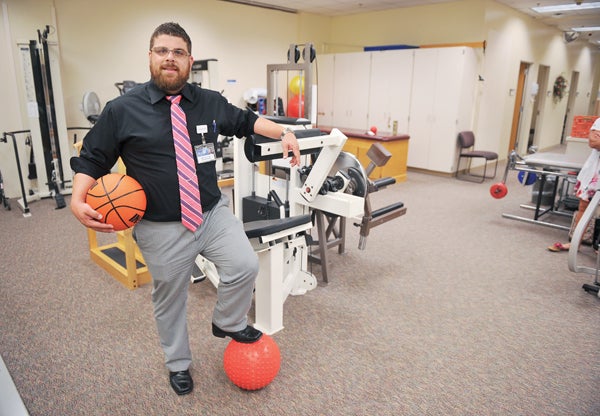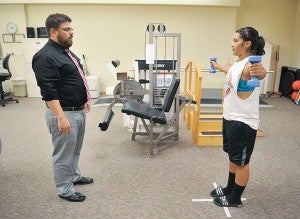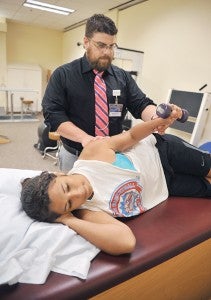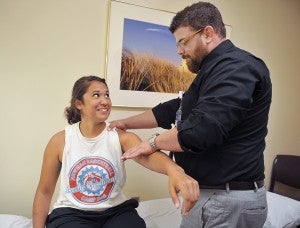Back on the Court
Published 9:00 am Monday, October 22, 2012

Isaac Schaan is a physical therapist at Mayo Clinic Health System in Austin who works to get people back up again and moving after injuries and surgery. -- Eric Johnson/Albert Lea Tribune
Isaac Schaan watched as 16-year-old Keely Zynda finished her rehab one Friday afternoon this summer, telling him she could finally do a pushup. Lying face up on an exercise table in the physical therapy department at Mayo Clinic Health System in Austin, she hopped to her feet, fell to the floor and proved herself right.

Sixteen-year-old Keely Zynda lifts a pair of weights under the watchful eye of Mayo Clinic Health System in Austin physical therapist Isaac Schaan. The exercise gives Schaan an idea of how Zynda, who is coming back from a shoulder dislocation and surgery, is progressing with arm strength.
A simple matter for others, this was no small achievement for Zynda, who just a few months ago underwent surgery to repair a chronic dislocating shoulder. She owed a lot of where she was to Isaac, her physical therapist. To Schaan, it’s the best part of his job.
Schaan has been a physical therapist at the medical center for four years. Originally from northern, rural North Dakota, he has always loved athletics, medicine and the intersection where they meet. Not fond of the long hours his hometown doctors put in, he thought physical therapy — diagnosing, evaluating, rehabilitating and returning patients to a pain free, normal life — may be more his speed. So he got his bachelor’s degree from Minnesota State University-Moorhead, his master’s degree from Mayo School of Health Sciences, in the physical therapy program in Rochester in 2004, and eventually found his way to Austin.
Schaan now treats primarily orthopedic outpatients, ranging from age 5 to 95, but enjoys working with athletes. He likes it enough that he also helps Austin Packers athletic trainer Kris Dutton at home sporting events, as well as the Austin Bruins hockey team when it’s at home.

Isaac Schaan works with 16-year-old Keely Zynda who is working back from a shoulder dislocation and the surgery that followed.
“Kind of for my own fun and benefit, to put my face out in the community … I will cover some of those sporting events,” Schaan said.
Along with the sprains and strains, Schaan also treats major injuries to knees, hips and shoulders. He and the other physical therapists at the medical center will treat most routine patients for four to eight weeks, but for those doing rehab after surgery, like Zynda, the process can take up to 12.
“Keely is an energetic patient, and for the most part listens and puts forth good effort,” Schaan said with a smile.
For the most part that means Zynda sometimes needs a little push or reassurance.”
“But really, she is motivated to get back to her sport,” Schaan said.
The process starts with work on the athlete’s range of motion and light strengthening. As they progress, they strive for full range of motion, higher level of strength activities and eventually rebuilding power and agility. The struggles and setbacks that occur along the way for most patients — those are part of the process.
“You’ve seen them almost at their worst, or in a lot of pain, frustrated with the pain, tired with the pain, and then, in the cases where those people recover, you get to see them smile,” he said. “And two months later they’re pain free and they’re back to doing the activities they enjoy. I think that’s very fulfilling, and it feels good to have been able to help somebody back to that point.”

Isaac Schaan assess the progress 16-year-old Keely Zynda is making with her shoulder rehab during a visit to Mayo Clinic Health System in Austin.
For Zynda, that means playing basketball again. The incoming sophomore at Austin High School has dealt with shoulder dislocations since she was 11. While Schaan helped her before, after a fall and subsequent dislocation ended her basketball season last winter, Zynda and her mother, Angelita Zynda, decided it was time for surgery.
“Once you stretch out that tissue, the prevalence of it happening again goes up,” Schaan said. “But now that it’s been repaired and tightened, it should be a non-issue.”
While a lot of the injuries are the same, the people are far from it. For Schaan, a self-described people person, that’s another benefit of physical therapy.
“It’s great working with athletes, visiting with people who come in and just getting to see people from all walks of life,” he said. “It keeps each day interesting as a therapist. A torn ACL is a torn ACL, but those conditions and the process that individual goes through varies with everyone who walks through the door.”
No matter who it is, part of the job is keeping them motivated and showing them why it’s important to get better.
“It’s straining, and it can be exhausting, but it’s part of the overall rehab process,” he said. “Most physical therapists would say we’re not just rehabbing a joint, we’re rehabbing the total individual to get them back to a happy, healthy normal lifestyle.”





